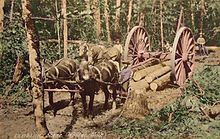Horse logging


Horse logging is the use of horses or mules in forestry. In the modern industrialized world, it is often part of sustainable forest management.
Horses may be used for skidding and other tasks.[1]
Net net and gross production rates using horse logging in a Romanian study were of 2.63 m3/h and 1.44 m3/h.[2]
In the United Kingdom, there were three people employed as horse loggers in the 1980s but the number increased to 15 by 2009 with up to 1,000 part-time employed by that work.[3]
Horses can efficiently extract a single damaged tree from a forest without roadbuilding required for powered vehicles.[4] The technique can be more efficient than using power equipment, considering the cost of transportation and fuel, especially on smaller privately held forest parcels.[5][6]

Equipment
- logging arch

- go-devil
- a simple, loosely articulated sled without thills (shafts) or a tongue generally used for skidding long logs behind a horse[1]
- scoot
- a heavy sled on which logs or bolts are carried completely off the ground in several different sizes, depending on the pulling power to be used, ranging from a horse to a heavy tractor[1]

- skidding harness
- often used when horse skidding to keep the trace chains away from the horses' heels[1]
See also
References
- ^ a b c d e Simmons 1962.
- ^ Borz & Ciobanu 2013.
- ^ Southam 2009.
- ^ Brown 2015.
- ^ Jenner 2013.
- ^ Kendell 2005.
Sources
- Borz, Stelian Alexandru; Ciobanu, Valentina (June 2013), "Efficiency of motor-manual felling and horse logging in small-scale firewood production", African Journal of Agricultural Research, vol. 8, no. 24, pp. 3126–3135
- Simmons, Fred C. (1962), "Skidding with horses" (PDF), Logging farm wood crops, United States Department of Agriculture, pp. 43–44, Farmers' bulletin Volume no.2090 also "Antifriction devices for skidding: pp 23-25
- Southam, Hazel (April 22, 2009). "A walk on the wild side: Horses are increasingly being used rather than machines to log land as traditional forestry skills make a comeback". The Guardian.
- Brown, Liz (April 29, 2015), "Horsepower: Using horses for farm work and logging", Horse Canada, Aurora, Ontario: Horse Media Group
- Jenner, Andrew (May 1, 2013), "Retro Farming: Horsepowered Logging", Modern Farmer
- Kendell, Chet (Spring 2005), "Economics of Farming with Horses—Career Cost of Horses versus Tractor", Rural Heritage
Further reading
- Tim Rowland (March 6, 2020). "Workhorses of sustainability". Adirondack Explorer.
- Ian McCluskey (November 9, 2017), Horse Logging At The Harmons: Oregon's last horse logger (Video with accompanying text), Oregon Field Guide, Oregon Public Broadcasting
- Animal logging in the US South and its application in the developing countries, FAO
- Tom Moates (December 2006), "Let's Go Horse Logging", Mother Earth News
- Sidbäck, Hans (1993). The Horse in the Forest: Caring, Training, Logging. Swedish University of Agricultural Sciences Research Information Centre/Forestry. ISBN 9157647623.
- Struber, Klaus (28 March 2018), "Horse Labor Instead of Tractors", Small Farmer's Journal, no. 39–4
- California Forestry Note 1983, California Department of Forestry and Fire Protection, 1983
External links
 Media related to Forestry with horses at Wikimedia Commons
Media related to Forestry with horses at Wikimedia Commons- Horse logging at heavyhorses.net

